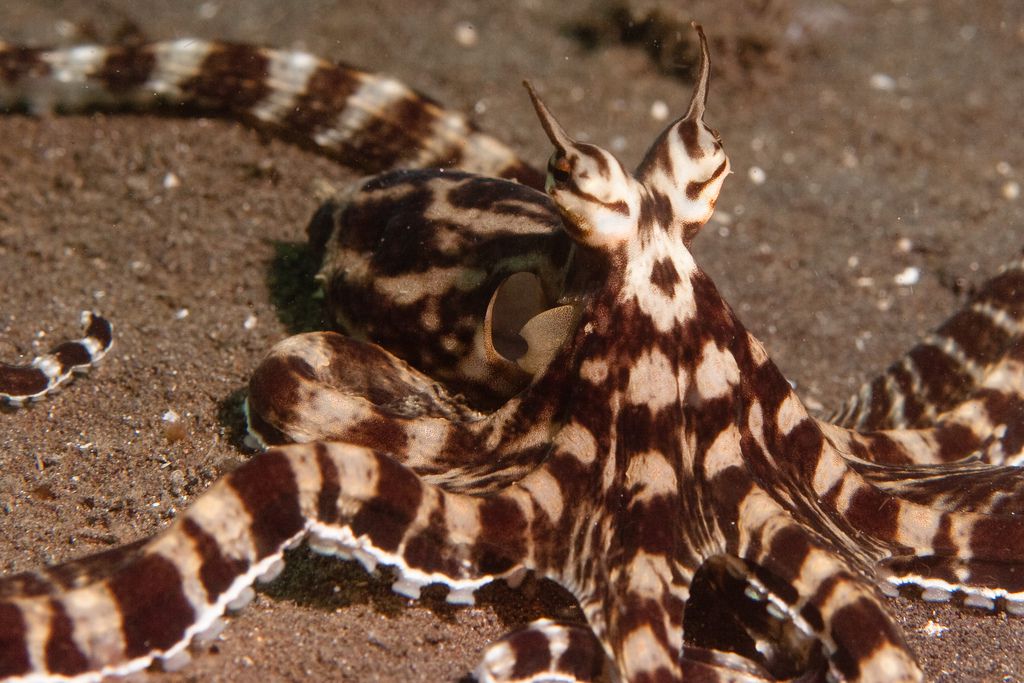This content is an HTML document that discusses 10 unbelievable mimicry abilities of various animals. The examples include leaf-tailed geckos that imitate leaf patterns, an orchid mantis that impersonates a flower, walking stick insects that resemble twigs, octopuses that blend into their surroundings, a tawny frogmouth that looks like a broken tree branch, a satanic leaf-tailed gecko that mimics a dead leaf, a blue-ringed octopus that displays warning signals, a peacock spider that performs an intricate dance routine, a satyr butterfly with eye-like wing patterns, and squid and flounders that change their skin color and pattern to match their environment.
10 Unbelievable Mimicry Abilities of Animals: Nature’s Master Impersonators
1. Leaf-Tailed Geckos
These incredible creatures have evolved to perfectly blend in with their surroundings by imitating leaf patterns and textures. Leaf-tailed geckos possess unique tails that resemble fallen leaves, allowing them to disappear seamlessly into the background.
2. Orchid Mantis
The orchid mantis takes its act to the extreme by perfectly impersonating a flower. With its petal-shaped body, vivid colors, and precise positioning on its prey like a blooming orchid, this deceptive insect attracts unsuspecting pollinators or insects it intends to ambush.
3. Walking Stick Insects
Walking stick insects are masters of camouflage, appearing as twigs or branches, complete with intricate details like bark-like patterns and thin bodies to mimic vegetation perfectly. This remarkable mimicry allows them to essentially vanish among plants, avoiding detection by predators.
4. Octopuses
Octopuses have an uncanny ability to morph their skin color and texture, enabling them to blend seamlessly into their surroundings. Whether it’s imitating coral, rocks, or even the seafloor, these cephalopods are nature’s ultimate masters of disguise.
5. Tawny Frogmouth
The tawny frogmouth, a bird native to Australia, is a masterful mimic of a broken tree branch. With its mottled plumage, gray coloration and unique body shape, it effortlessly blends into its surroundings, making it nearly impossible to spot.
6. Satanic Leaf-Tailed Gecko
This species of gecko mimics a dead leaf, complete with discoloration and irregular surface texture. Its ability to flatten its body against a tree trunk accentuates its disguise, making it nearly invisible to predators.
7. Blue-Ringed Octopus
While small, the blue-ringed octopus packs a potent venomous bite. To avoid being eaten, it displays vibrant and iridescent blue rings all over its body when threatened, acting as a warning signal to would-be predators. Its beautiful appearance serves as a reminder that, in nature, beauty can harbor danger.
8. Peacock Spider
The male peacock spider takes mimicry to new heights, performing an intricate dance routine to attract females. Alongside its enchanting movements, it displays vibrant colors and patterns on its abdomen, resembling a miniature peacock’s tail, hence its name.
9. Satyr Butterfly
The satyr butterfly has developed fascinating wing patterns that perfectly imitate the eyes of larger creatures, such as predatory birds. These “eye spots” confuse and startle predators, giving the butterfly a precious few moments to evade capture.
10. Squid and Flounder
Squid and flounders are masters of disruptive coloration. They actively change the color and pattern of their skin to match their environment or create distracting patterns to confuse predators. This remarkable ability allows them to deceitfully blend into their surroundings, ensuring their survival.
